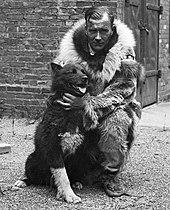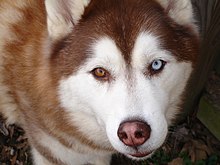 | ||||||||||||||||||||||||||||
| A black and white male Siberian Husky | ||||||||||||||||||||||||||||
| Other names | Chukcha, Chuksha | |||||||||||||||||||||||||||
|---|---|---|---|---|---|---|---|---|---|---|---|---|---|---|---|---|---|---|---|---|---|---|---|---|---|---|---|---|
| Nicknames | Husky, Icee, Sibe | |||||||||||||||||||||||||||
| Country of origin | Siberia, Russia | |||||||||||||||||||||||||||
| ||||||||||||||||||||||||||||
| ||||||||||||||||||||||||||||
| Dog (Canis lupus familiaris) | ||||||||||||||||||||||||||||
The Siberian Husky (Russian: сибирский хаски, "Sibirsky husky") is a medium to large, dense-coat working dog breed that originated in north-eastern Siberia. The breed belongs to the Spitz genetic family.[2] It is recognizable by its thickly furred double coat,sickle tail, erect triangular ears, and distinctive markings.
Huskies are an active, energetic, and resilient breed whose ancestors came from the extremely cold and harsh environment of the Siberian Arctic. Siberian Huskies were bred by the Chukchi of Northeastern Asia to pull heavy loads long distances through difficult conditions. The dogs were imported into Alaska during the Nome Gold Rush and later spread into the United States and Canada. They were initially sent to Alaska and Canada as sled dogs but rapidly acquired the status of family pets and show dogs.
Contents
[hide]History[edit]
The Siberian Husky, Samoyed, and Alaskan Malamute are all breeds directly descended from the original sled dog, which 2004 DNA analysis confirms is one of the oldest breeds of dog.[3][4] It is thought that the term "husky" is a corruption of the nickname "Esky" once applied to the Eskimos and subsequently to their dogs.[5]
Breeds descending from the Eskimo dog or Qimmiq [6] were once found throughout the Northern Hemisphere from Siberia to Canada, Alaska,Greenland, Labrador, and Baffin Island.[7]
With the help of Siberian Huskies, entire tribes of people were able not only to survive, but to push forth into terra incognita. Admiral Robert Pearyof the United States Navy was aided by this breed during his expeditions in search of the North Pole.[7]
Dogs from the Anadyr River and surrounding regions were imported into Alaska from 1908 (and for the next two decades) during the gold rush for use as sled dogs, especially in the "All-Alaska Sweepstakes," a 408-mile (657-km) distance dog sled race from Nome, to Candle, and back. Smaller, faster and more enduring than the 100- to 120-pound (45- to 54-kg) freighting dogs then in general use, they immediately dominated the Nome Sweepstakes. Leonhard Seppala, the foremost breeder of Siberian Huskies of the time, participated in competitions from 1909 to the mid-1920s.[7]
On February 3, 1925, Gunnar Kaasen was first in the 1925 serum run to Nome to deliver diphtheria serum from Nenana, over 600 miles to Nome. This was a group effort by several sled-dog teams and mushers, with the longest (91 miles or 146 km) and most dangerous segment of the run covered by Leonhard Seppala. The Iditarod Trail Sled Dog Race commemorates this famous delivery. The event is also loosely depicted in the 1995 animated film Balto, as the name of Gunnar Kaasen's lead dog in his sled team was Balto, although unlike the real dog, Balto the characterwas portrayed as half wolf in the film. In honor of this lead dog, a bronze statue was erected at Central Park in New York City. The plaque upon it is inscribed,
Dedicated to the indomitable spirit of the sled dogs that relayed antitoxin six hundred miles over rough ice, across treacherous waters, through Arctic blizzards from Nenana to the relief of stricken Nome in the winter of 1925. Endurance · Fidelity · Intelligence[7]
In 1930 exportation of the dogs from Siberia was halted.[8] The same year saw recognition of the Siberian Husky by the American Kennel Club. Nine years later, the breed was first registered in Canada. The United Kennel Club recognized the breed in 1938 as the "Arctic Husky," changing the name to Siberian Husky in 1991.[9] Seppala owned a kennel in Nenana before moving to New England, where he became partners with Elizabeth Ricker. The two co-owned the Poland Springs kennel and began to race and exhibit their dogs all over the Northeast.
As the breed was beginning to come to prominence, in 1933 Navy Rear Admiral Richard E. Byrd brought about 50 Siberian Huskies with him on an expedition in which he hoped to journey around the 16,000-mile coast of Antarctica. Many of the dogs were trained at Chinook Kennels in New Hampshire. Called Operation Highjump, the historic trek proved the worth of the Siberian Husky due to its compact size and greater speeds.[7] Siberian Huskies also served in the United States Army's Arctic Search and Rescue Unit of the Air Transport Command during World War II.[10] Their popularity was sustained into the 21st century. They were ranked 16th among American Kennel Club registrants in 2012.[11]
The original sled dogs bred and kept by the Chukchi were thought to have gone extinct, but Benedict Allen, writing for Geographical magazine in 2006 after visiting the region, reported their survival. The best sleding dog out of all dogs because of the thick coat of fur that keeps them warm and protected.[12]
Description[edit]
Coat[edit]
A Siberian Husky's coat is thicker than most other dog breeds,[13] comprising two layers: a dense undercoat and a longer topcoat of short, straight guard hairs. It protects the dogs effectively against harsh Arctic winters, but the coat also reflects heat in the summer. It is able to withstand temperatures as low as −50 to −60 °C (−58 to −76 °F). The undercoat is often absent during shedding. Their thick coats require weekly grooming.[13] In hot areas a husky's coat can naturally change so the dog can adapt to hot temperatures.
Siberian Huskies come in a variety of colours and patterns, usually with white paws and legs, facial markings, and tail tip. The most common coats are black and white, then less common copper-red and white, grey and white, pure white, and the rare "Agouti" coat, though many individuals have blondish or piebald spotting. Striking masks, spectacles, and other facial markings occur in wide variety. Merle coat patterns are not allowed.
Eyes[edit]
The American Kennel Club describes the Siberian Husky's eyes as "an almond shape, moderately spaced and set slightly obliquely." The eyes of a Siberian Husky are pale blue, dark blue, amber, green, or brown. In some individual dogs, one eye may be brown and the other blue (complete heterochromia), or one or both eyes may be "parti-colored," that is, half brown and half blue (partial heterochromia) All of these eye-color combinations are considered acceptable by the American Kennel Club.
Nose[edit]
Show-quality dogs are preferred to have neither pointed nor square noses. The nose is black in gray dogs, tan in black dogs, liver in copper-colored dogs, and may be light tan in white dogs. In some instances, Siberian Huskies can exhibit what is called "snow nose" or "winter nose." This condition is called hypopigmentation in animals. "Snow nose" is acceptable in the show ring.[13][14]
Tail[edit]
Siberian Husky tails are heavily furred; these dogs will often curl up with their tails over faces and noses in order to provide additional warmth. The tail should be expressive, held low when the dog is relaxed, and curved upward in a "sickle" shape when excited or interested in something. It should be symmetrical, and not curved or deviated to the side; nor should it ever curl so much as to touch the back.[13]
Size[edit]
The breed standard indicates that the males of the breed are ideally between 21 and 23.5 inches (53 and 60 cm) tall at the withers and weighing between 45 and 60 pounds (20 and 27 kg). Females are smaller, growing to between 20 to 22 inches (51 to 56 cm) tall at the withers and weighing between 35 to 50 pounds (16 to 23 kg).[13]
Behavior[edit]
The Husky has been described as a behavioral representative of the domestic dog's forebearer, the wolf, exhibiting a wide range of its ancestors' behavior.[15] They are known to howl rather than bark.[16] If the dog is well trained when it's young, it can make an ideal family pet. They are affectionate with people of all ages. Behavioral issues include a tendency to roam and to make escape attempts.[1][17] The ASPCA classifies the breed as good with children. It states they exhibit high energy indoors, have special exercise needs, may pursue cats, and may be destructive "without proper care."[1] They are escape artists, can jump and they love to run. A 6 ft fence is recommended for this breed as a pet. They need the frequent companionship of people and other dogs.[8]
A fifteen-minute daily obedience training class has been shown to serve well for Siberian Huskies.[18] Siberians need consistent training and do well with a positive reinforcementtraining program. They rank 45th in Stanley Coren's The Intelligence of Dogs, being of average working/obedience intelligence. They tend to run because they were at first bred to be sled dogs. They were historically bred to be working and companion animals by the Chukchi people, and should always be gentle in nature. The Chukchi people use Siberian huskies to look after their children.[19]
Health[edit]
A 1999 ASPCA publication gives the life span of the Siberian Husky as 12 to 14 years.[1] Health issues in the breed are mainly genetic, such as seizures and defects of the eye (juvenile cataracts, corneal dystrophy, canine glaucoma and progressive retinal atrophy) and congenital laryngeal paralysis.[20] Hip dysplasia is not often found in this breed; however, as with many medium or larger-sized canines, it can occur.[21] The Orthopedic Foundation for Animals currently has the Siberian Husky ranked 155th out of a possible 160 breeds at risk for hip dysplasia, with only two percent of tested Siberian Huskies showing dysplasia.[22]
Siberian Huskies used for sled racing may also be prone to other ailments, such as gastric disease,[23] bronchitis or bronchopulmonary ailments ("ski asthma"),[24] and gastric erosions or ulcerations.[25]
Modern Siberian Huskies registered in the US are largely the descendants of the 1930 Siberia imports and of Leonhard Seppala’s dogs, particularly Balto.[26] The limited number of registered foundational dogs has led to some discussion about their vulnerability to the founder effect.[27]
Famous Siberians[edit]
Siberians gained in popularity with the story of the "Great Race of Mercy," the 1925 serum run to Nome, which made dogs Balto and Togo famous. Though Balto is the more famous of the two, and was the dog to deliver the serum to Nome after running the final 53-mile leg, it was Togo who made the longest run of the relay, guiding his musherLeonhard Seppala on a 91-mile journey that included crossing the deadly Norton Sound to Golovin.
Several purebred Siberian Huskies portrayed Diefenbaker, the "half-wolf" companion to RCMP Constable Benton Fraser, in the CBS/Alliance Atlantis TV series Due South.[28]
In 1960, the US Army undertook a project to construct an under the ice facility for defense and space research, Camp Century, part of Project Iceworm involved a 150+ crew who also brought with them an unofficial mascot, a Siberian Husky named Mukluk.[29]
Siberian Huskies are the mascots of the athletic teams of several schools and colleges, including Northern Illinois University (Northern Illinois Huskies),[30] the University of Connecticut (Connecticut Huskies, Jonathan) and University of Washington (Washington Huskies, Harry).






chenlina20160506
ResponderExcluirralph lauren
coach outlet
jordan 4
celine handbags
tiffany and co
louis vuitton outlet
polo ralph lauren
coach factory outlet
tory burch outlet
louis vuitton
fitflops sale clearance
louboutin pas cher
jordan retro
lebron 11
fitflop sandals
hollister kids
michael kors outlet
ghd hair straighteners
toms shoes
adidas originals
ralph lauren polo
coach factory outlet
basketball shoes
oakley sunglasses
michael kors outlet
ray ban sunglasses
michael kors outlet
tory burch outlet online
michael kors handbags
kate spade
jordan 3
cheap air jordans
polo ralph kids
christian louboutin outlet
kevin durant shoes 7
ralph lauren outlet
michael kors canada
michael kors uk
michael kors outlet clearance
jordans for sale
as